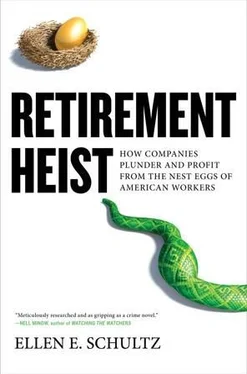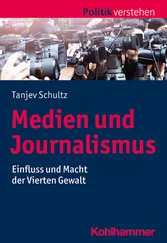Intel’s move wasn’t illegal, though it had a peculiar result: It turned a pension plan for a company with more than fifty thousand workers primarily into a fund to pay for the deferred compensation of the company’s most highly paid employees, roughly 4 percent of the workforce.
If it were this easy for all employers to just shift executive liabilities into their employee pension plans, they would all have done so long ago. But tax rules put up a roadblock. To get tax breaks, pensions have to be open to a broad group of employees and can’t discriminate in favor of the highly paid.
Benefits consultants, however, found a loophole in the discrimination rules that has enabled a growing number of large companies to shift hundreds of millions of dollars of executive liabilities into rank-and-file pensions. Using complex and proprietary formulas, the consultants determine how much discrimination a pension plan can achieve without technically violating discrimination rules.
The result might be a dollar amount, say, $200 million, which would be allocated to highly paid employees in addition to their regular benefits from the plan. In Intel’s case, the participants got their regular pension, plus an amount of their deferred compensation paid from the pension. These arrangements are often called QSERPs, which stands for “qualified supplemental executive retirement plan.”
The shift doesn’t increase the total amount a person receives; when the executive liability is moved to the pension plan, an equivalent amount of deferred compensation or supplement executive pension is canceled. The goal of the maneuver isn’t to boost executive benefits but to harness the pension plan to pay them. “QSERPs clearly offer a tremendous opportunity for some employers to prefund key executive retirement benefits,” noted Watson Wyatt’s marketing material.
Intel and its pension plan were healthy. But companies in financial distress have an incentive to do this, and when they shovel executive obligations into underfunded pension plans, the result can backfire.
In December 2002, Oneida Ltd., a flatware maker in upstate New York, amended its pension to give then chairman and CEO Peter J. Kallett an additional pension of $301,163 a year in retirement. This was in addition to the $116,000 a year he was already eligible for in the regular pension. The company then transferred the liability for that additional amount from his executive pension.
The company made a similar amendment for another executive in April 2004, boosting his pension from less than $33,000 a year to a minimum of $246,353 a year in retirement. The timing wasn’t great. The company was struggling financially, and the pension plan was already significantly underfunded. Two weeks after awarding the pension increase to the second executive, Oneida was supposed to make a mandatory $939,951 contribution to its pension fund. But it didn’t. Instead it froze the pension, which meant that employees would no longer build any benefits. But the freeze didn’t affect executives’ pensions under the QSERP, because these were already set at a certain amount that wouldn’t grow over time anyway. Neither the company nor the plan survived. In 2006, Oneida terminated its pensions in bankruptcy court and transferred the obligations to the PBGC. It also laid off most of its employees. Donald Grogan, who was fifty-two at the time, had worked in manufacturing and shipping at Oneida for twenty-two years before he lost his job. Because the pension plan had been handed over to the PBGC, he had to wait until 2009, when he turned fifty-five, to begin drawing his pension. To make ends meet, he got a truck-driving job with no benefits.
On the other side of the country, a similar drama left Chester Madison with a gutted pension. He had been a middle manager at Consolidated Freightways Corp., a trucking company based in Vancouver, Washington. In late 2001, when the company was clearly in trouble, it transferred most of the retirement IOUs for eight top officers into its pension.
The executives believed this would protect most or all of their supplemental pensions—which could reach $139,000 a year when they retired—because they’d be paid from the pension plan’s trust fund instead of the company’s operating cash.
They also felt more secure knowing that once executive liabilities are transferred into a “qualified” pension plan, they, too, are covered by the PBGC. When consulting firms market these strategies to upper management, that’s a key selling point. By contrast, deferred compensation and supplemental executive pensions are unsecured promises, which creditors can claim if the employer goes under. Many Enron executives learned about this risk the hard way when they lost millions in deferred-compensation savings when the energy giant collapsed in 2001.
CFC executives soon found out how secure they actually were. The company hadn’t been contributing to the pension plan, which was growing steadily weaker. Adding the executive liabilities to the lifeboat swamped it. The plan’s funding went from having about 96 percent of the assets needed to pay promised benefits to having just 79 percent.
The next year, Consolidated filed for bankruptcy, and in 2003 it handed its pension plan over to the PBGC. Consolidated executives lost a chunk of their pensions because the maximum PBGC payout at the time was $44,000 a year at age sixty-five, and is far less at earlier ages and when other factors are applied.
When Chester Madison retired in 2002, after thirty-three years, his pension fell to $20,400 a year from $49,200, which forced him, at age sixty-two, to take a job selling flooring in Sacramento.
Consultants have since devised solutions to reduce risk for the top managers. In 2005, when Hartmarx shifted executive liabilities into the regular pension plan, it also established an unfunded trust to benefit fewer than a dozen executives, including chief financial officer Glenn R. Morgan. A Chapter 11 bankruptcy filing would trigger the funding of the trust, assuring that the executive benefits it had transferred into the regular pension would be paid even if the pension plan failed.
That was a smart move by the Chicago-based maker of high-end men’s suits. In 2009, when its lenders cut off its credit, the company filed for Chapter 11. The company survived: It was acquired by SKNL North America BV, a subsidiary of an Indian textile maker, and renamed HMX. The pension plan didn’t: The new owners had no interest in being saddled with the underfunded pension plan covering thirteen thousand employees and retirees and dumped the plan on the PBGC’s doorstep. At that point, the pension plan was only 47 percent funded.
No one knows how many hundreds of millions of SERP and deferred-compensation obligations have been transferred into employee pension plans since the practice emerged in the 1990s. The Milliman consultant who advised employers to tell only the participating executives about the arrangements was also concerned about the IRS’s reaction. He advised employers that in “dealing with the IRS,” they should ask it for an approval letter, because if the agency later cracks down, its restrictions probably won’t be retroactive.
“At some point in the future, the IRS may well take the position” that supplemental executive pensions moved into a regular pension plan “violate the ‘spirit’ of the nondiscrimination rules,” he wrote. Companies have been able to blow the practice past the IRS because, when they file the amendments, they don’t explicitly note the purpose of the change and include it with a flurry of other technical amendments. In any case, the IRS staff is stretched too thin to scrutinize the dozens of pages of complex calculations companies perform to prove that they don’t discriminate. In contrast with a deduction a freelance worker might take for a home office, the IRS generally accepts an employer’s word that its pension plan doesn’t discriminate. To halt the practice, Congress would have to end the flexibility that companies now have in meeting the IRS nondiscrimination tests, which is something employers have strongly opposed.
Читать дальше












